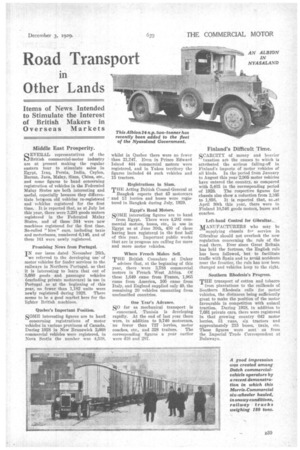Road Transport
Page 65

If you've noticed an error in this article please click here to report it so we can fix it.
Other Lands
Middle East Prosperity.
SEVERAL representatives of the British commercial-motor industry are at present making the regular eastern tour to stimulate sales in Egypt, Iraq, Persia, India, Ceylon, Burma. Java, Malay, Siam, China, etc., and some figures to hand concerning registration of vehicles in the Federated Malay States are both interesting and useful, especially because they differentiate between old vehicles re-registeFed and vehicles registered for the first time. It is reported that, as at July 1st this year, there were 3,291 goods motors registered in the Federated Malay States, and of these 344 were new machines registered far the first time. So-called " hire" cars, including taxis and motorbuses, numbered 6,146, and of these 161 were newly registered.
Promising News from Portugal.
IN our issue dated November 26th,
we referred to the developing use of motor vehicles for feeder services to the railways in Northern Portugal, so that it is interesting to learn that out of 5,680 goods and passenger vehieles (excluding private motorcars) in use in Portugal as at the beginning of this year, no fewer than 1,182 units were
newly registered during 1928. There seems to be a good market here for the lighter British machines, Quebec's Important Position.
SOME interesting figures are to hand concerning registrations of motor vehicles in various provinces of Canada. During 1928 in New Brunswick 2,668 commercial vehicles were registered, in Nova Scotia the number was 4,538, whilst in Quebec there were no fewer than 21,747. Even in Prince Edward Island 444 commercial motors were registered, and in Yukon territory the figures included 44 such vehicles and 15 tractors: Registrations in Siam.
THE Acting British Consul-General at Bangkok reports that 43 motorcars and 13 lorries, and buses were registered in Bangkok during July, 1929.
Egypt's Road Motors.
SOME interesting figures are to hand
from Egypt. There were 4,202 commercial motors, buses etc., in use in Egypt as at June 30114, 450 of these having been registered in the first half of this year. Important public works that are in progress are calling for more and more motor vehicles.
Where French Makes Sell. THE British Consulate at Dakar advises that, at the beginning of this year, there were 3,788 commercial motors in French West Africa. Of these 1,649 came from France, 1,965 came from America, 105 came from Italy, and England supplied only 49, the remaining 20 vehicles emanating from unclassified countries.
One Year's Advance,
SO far as mechanical transport is
concerned, Tunisia is developing rapidly. At the end of last year there were, in addition to 9,740 motorcars, no fewer than 727 lorries, motor coaches, etc., and 328 trailers. The corresponding figures a year earlier were 438 and 287.
Finland's Difficult Time.
SCARCITY of money and heavier taxation are the causes to which is attributed the serious falling-off in Finland's imports of motor vehicles of all kinds. In the period from January to August this year 2,905 motor vehicles have entered the country, as compared with 5,405 in the corresponding period of 1928. The respective figures for chassis also show a reduction from 2,105 to 1,898. It is reported that, as .at April 20th this year, there were in Finland 10,546 goods motors, buses and coaches.
Left-hand Control for Gibraltar.
MANTIFAC'TURERS who may be supplying chassis for service in Gibraltar should not overlook the new regulation concerning the rule of the road there. Ever since Great Britain has held the fortress, the English rule has been followed, but to facilitate traffic with Spain and to avoid accidents near the frontier, the rule has now been changed and vehicles keep to the right.
Southern Rhodesia's Progress.
Tull transport of cotton and tobacco from plantations to the railheads of Southern Rhodesia calls for motor vehicles, the distances being sufficiently great to make the position of the motor favourable in competition with animal traction. During 1928, in addition to 7,681 private cars, there were registered in that growing country 642 motor lorries, 51 vans, six tractors and approximately 215 buses, taxis, etc. These figures were sent us from the Imperial Trade Correspondent at Bulawayo.




















































































































